Good morning everyone, and welcome back to the Mirror Gallery here on Hipsters of the Coast!
My Behind the Brush series returns this week amongst the Adventures in the Forgotten Realms previews with another very special guest. She was one of Magic’s first female Black artists to join the game with the Black is Magic Secret Lair set earlier this year, and her second card just debuted as a part of the Secret Lair All Natural, Totally Refreshing Superdrop’s Mother’s Day 2021 set.
We’ll hear about both of these illustrations, as well as where she’s come from and where she’s going in today’s interview, so without further ado, let’s open up the Mirror Gallery doors to Ejiwa “Edge” Ebenebe!
Introduction
Donny: Good morning Edge, and welcome to the Mirror Gallery here on Hipsters of the Coast! I like to start off with introductions, so if you could: Who are you, where are you from, and what do you do?
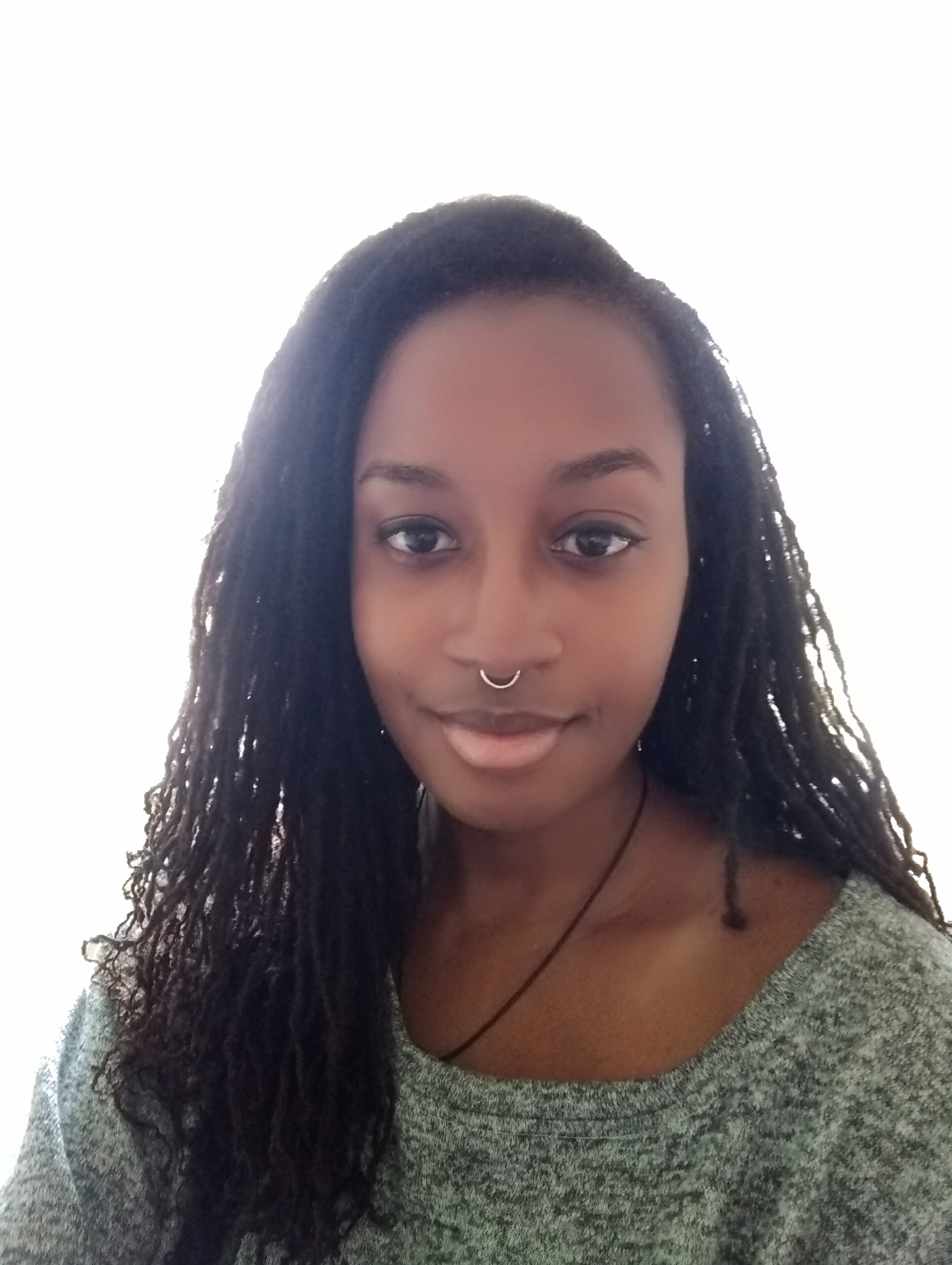
Edge: Hey Donny, thanks for having me! I’m Ejiwa Ebenebe, but I usually go by Edge. I’m a queer Nigerian-Canadian Illustrator and Fine Artist currently living in BC, Canada, and I’ve been a full-time freelancer for just over two years now.
My personal work explores unapologetic Black existence and joy, influenced by a lifelong love of ethereal, whimsical fantasy, and I aim to help add vibrant, positive representation for those who are often pushed out of those narratives and experiences.
Can you tell me a bit about your background? Where you grew up, how long you’ve been creating art, if/when you went to art school, and where your artistic journey has taken you?
I was born in and spent the bulk of my childhood in Lesotho, and the rest of my childhood/adolescence in Western Samoa. I then went to study in New Zealand, before eventually immigrating with my family to Canada, where we’ve been living since (for almost a decade now!).
I realise it’s a super cliche answer, but I really don’t remember a time I wasn’t creating in some form or another, I’ve just always enjoyed exploring it. As a child I would experiment with different ways of making things, from (attempted) wood carving, to sewing, to sketching, etc.
I discovered digital painting and 3D modeling sometime in my early teens I think, and was hooked. I didn’t go to formal school for Illustration or Fine Art, instead I learned through a combination of exploration, self-directed learning & online art courses/mentorships. I did however decide to get formal education in 3D Film Production, and while I’m mainly focused on 2D work now, I feel like that 3D knowledge and interest continuously weaves its way into my work in varying ways.
Is your work largely personal, or freelance, or a bit of both? Where might folks have seen your work before?
So far it’s been a mixture of both, but it’s leaning heavily towards freelance at the moment. I’d like to get better at balancing this with finishing personal work though (but also this seems to be a perpetual lament of freelance artists, haha).
Most recently, apart from Magic, folks might have seen my work in The Literary Tarot & F(r)iction both by the Brink Literacy Project, ImagineFX, a couple of murals (for my fellow Vancouver, BC folks), and on a few recent Marvel variant covers, among other things.
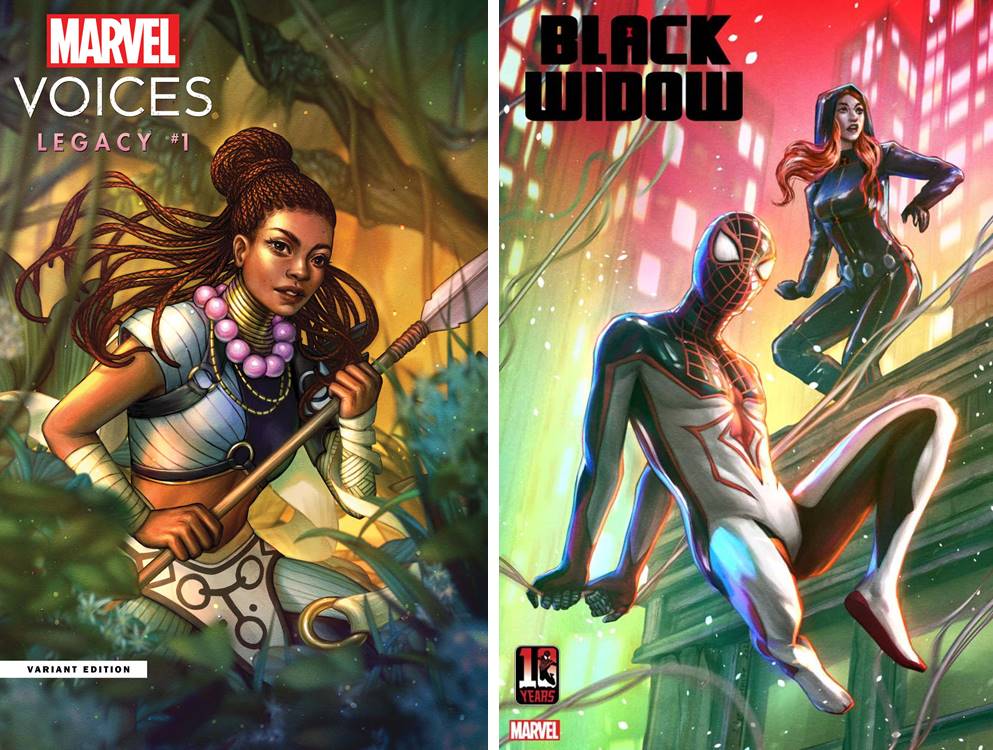
And I see you work both digitally and traditionally, and I believe in several different mediums too? How do you decide when approaching a particular piece?
It’s so fun! I love exploring, mixing and matching varying mediums; it’s really exciting to me to find ways to work different things I love into what I’m making.
I’m relatively new to traditional work though, especially compared to my digital painting experience. I’ve dipped briefly in and out of it over the years, but it’s only in the last couple of years I’ve really started digging deeper into it. And so when it comes to deciding a medium for my current work, I’m mostly going based on my confidence/efficiency level – the vast majority of my commercial work has been completely digital so far.
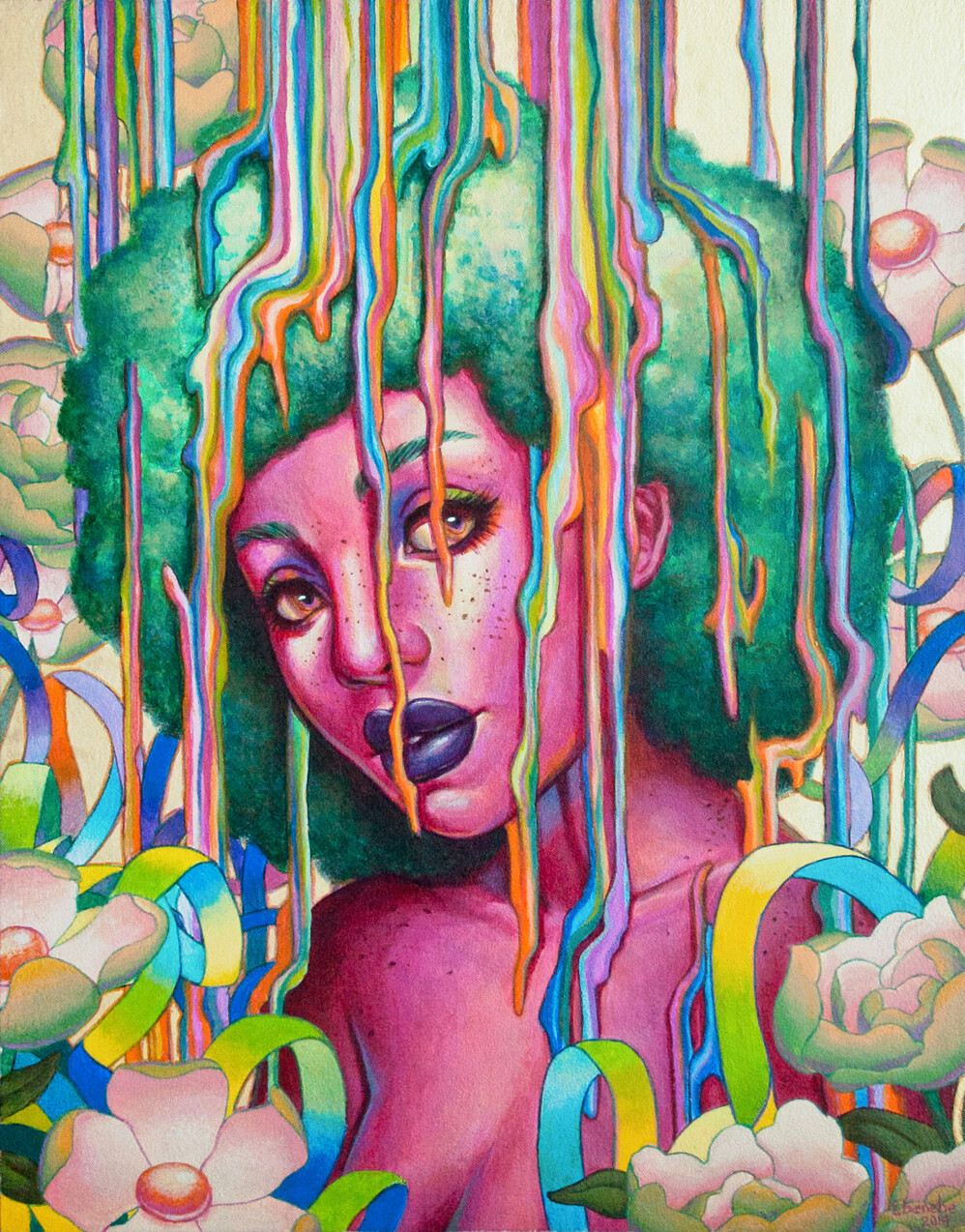
Candy Coating by Edge, Acrylic and Iridescent Pigment on Primed Wooden Panel. 11” x 14.
However as I’m gaining more experience in traditional mediums, I’m now looking to find ways to incorporate it into my overall artwork process. Ideally I’d love to find a hybrid process that weaves together what I find engaging about working both digitally and traditionally.
Do you have any art heroes, or particular places where you draw inspiration from?
I’m in awe of so, so many artists that I couldn’t possibly list them all sadly, but a few that pop to mind right now are Donato Giancola, Joy Ang, Andrew Hem, Chris Hong, Linda Bergkvist, Jeremy Enecio, Thomas Blackshear, James Jean, Paul Davey (Mattahan), Emely Pascual (Aquiboni), Eunice Cruzabra (Eunpyon), Seung Hee Han (Naked Cherry), Joao Ruas, Eliza Ivanova, Kristin Kwan, Bao Pham & Sam Weber.
Generally I find inspiration springing up all over the place, from random clutter around me, to music I’m listening to, etc. I especially love researching things, and the sheer number of internet rabbit holes is perfect for this.
In addition to learning about things directly related to the work I’m making, I find it fascinating learning about all sorts of topics I stumble across, such as fashion, plants, microorganisms, textile design, couture, sewing, item restoration, wilderness survival, programming, woodworking, etc. and even though they may seem disconnected, I really find that exploring my random interests continuously sparks new ideas for me.
What an inspiring list of folks and, just, things! Incredible. You note your “style” on Instagram as “Whimsical Maximalism” and I just love that descriptor—can you tell me what that means?
I’m happy to hear that! Haha, it’s a recent one I’m trying out – I really struggle to put my feelings about my work into words, but I stumbled upon the maximalism design scene not too long ago, and it was like discovering a visual representation of the feelings swirling around in my head!
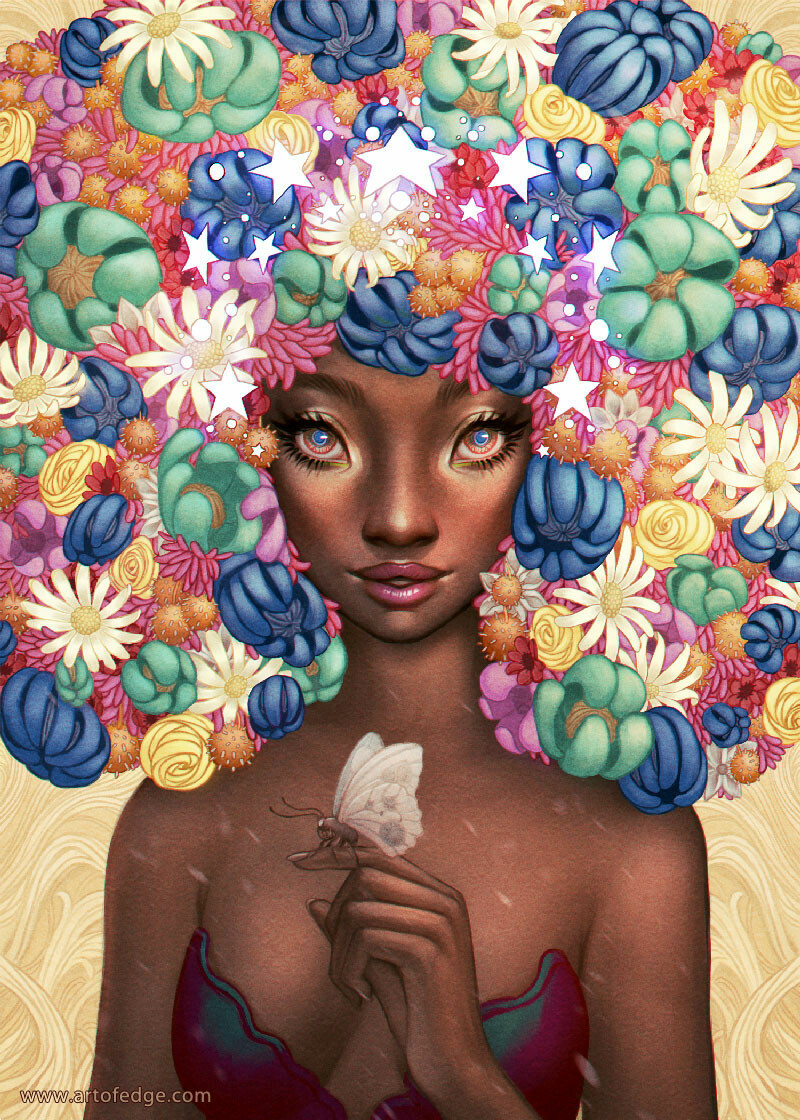
Flower Crown by Edge. Digital.
It seemed like a perfect encapsulation of the energy I’ve been striving for in my recent work (‘hyper whimsy’ also keeps coming to mind) – I’ve become increasingly fascinated by fun, over-the-top visuals and colours, and seem to developing an especially strong passion for unbridled kitsch, and so I’m currently exploring it and seeing if the descriptor feels right in the long term (or brings me closer to something that does).
I think that definition is the perfect segue into looking at your Magic cards! Let’s go to it!
Ponder
Let’s start with your first card, Ponder! How did this commission come about, and where did you begin?
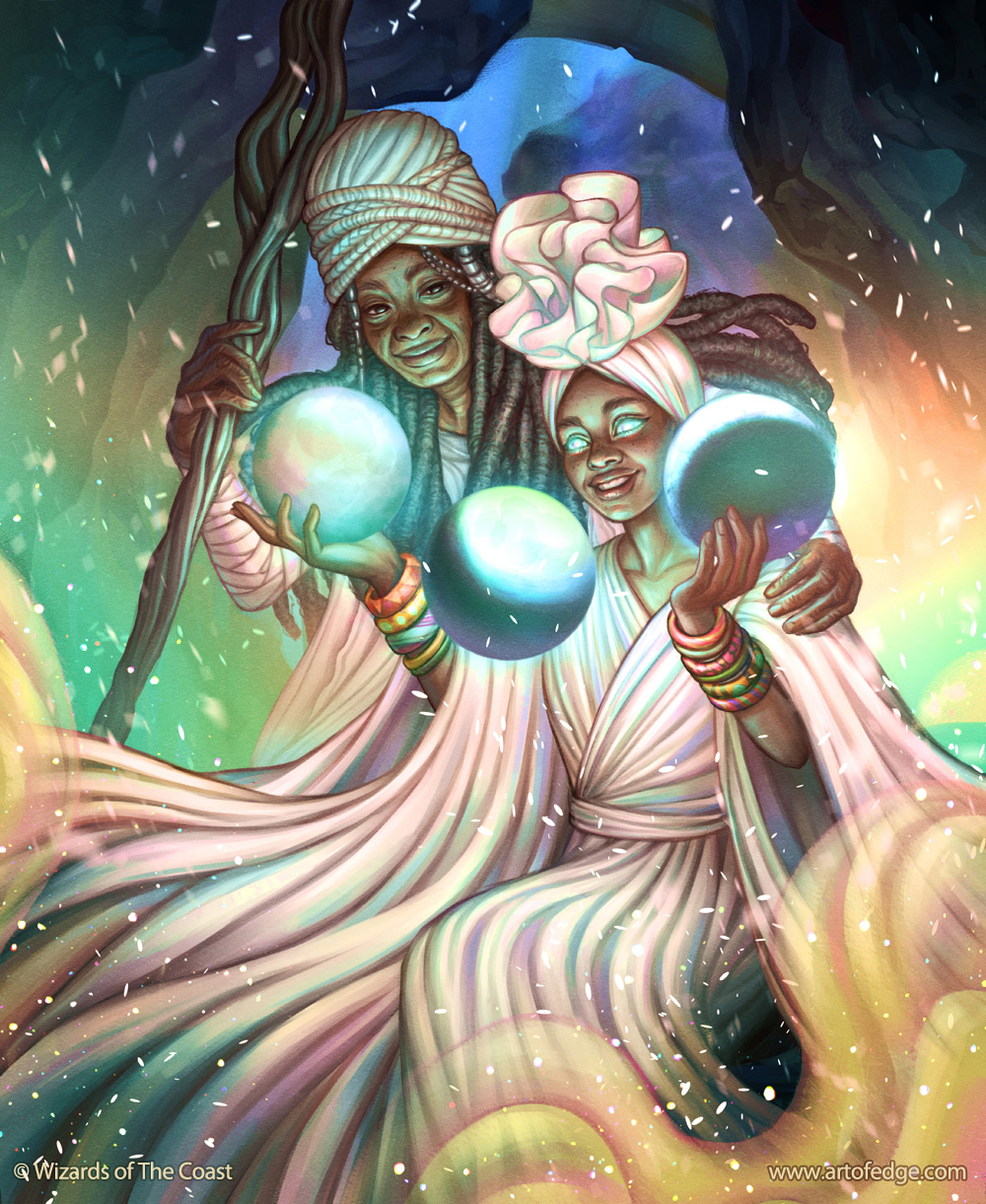
Ponder by Edge. Digital.
Maxx Marshall, my art director for Ponder, popped into my inbox one day and invited me on board – I remember seeing the email pop up and doing a double take, I’m still stunned about that!
Maxx then sent me a brief outlining the essential details needed for the card (such as the setting, story, character descriptions, etc.) and after reading through it I started sketching out what was coming to mind.
There is such a strong narrative to this artwork- we see Rielle the Everwise, but who is the younger character casting the ‘Ponder’ spell? How did you go about telling this story, especially with needing to include all these elements from other parts of Magic?
The initial brief was quite specific about the staging and character designs & dynamics, and I was also able to reference the atmosphere and energy of the iconic preceding Ponder cards.
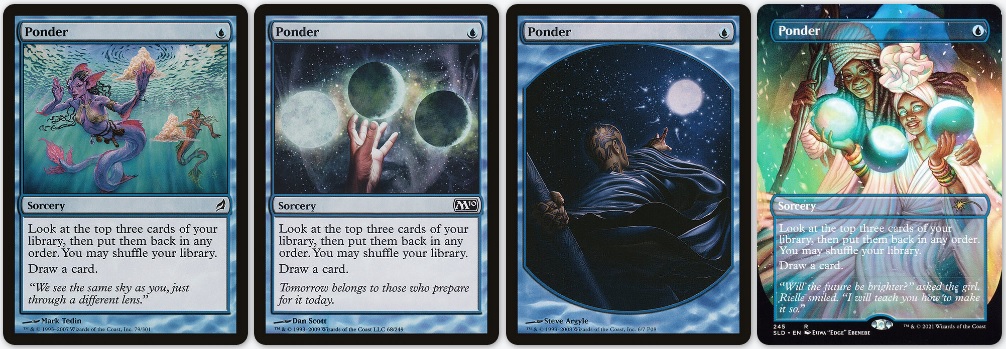
As a result the visuals felt really intuitive to develop, I simply aimed to convey the feeling of this magical moment as effectively as I could. I really wanted to express the magic and wonder I felt after reading the card’s outline and studying the Ponder cards.
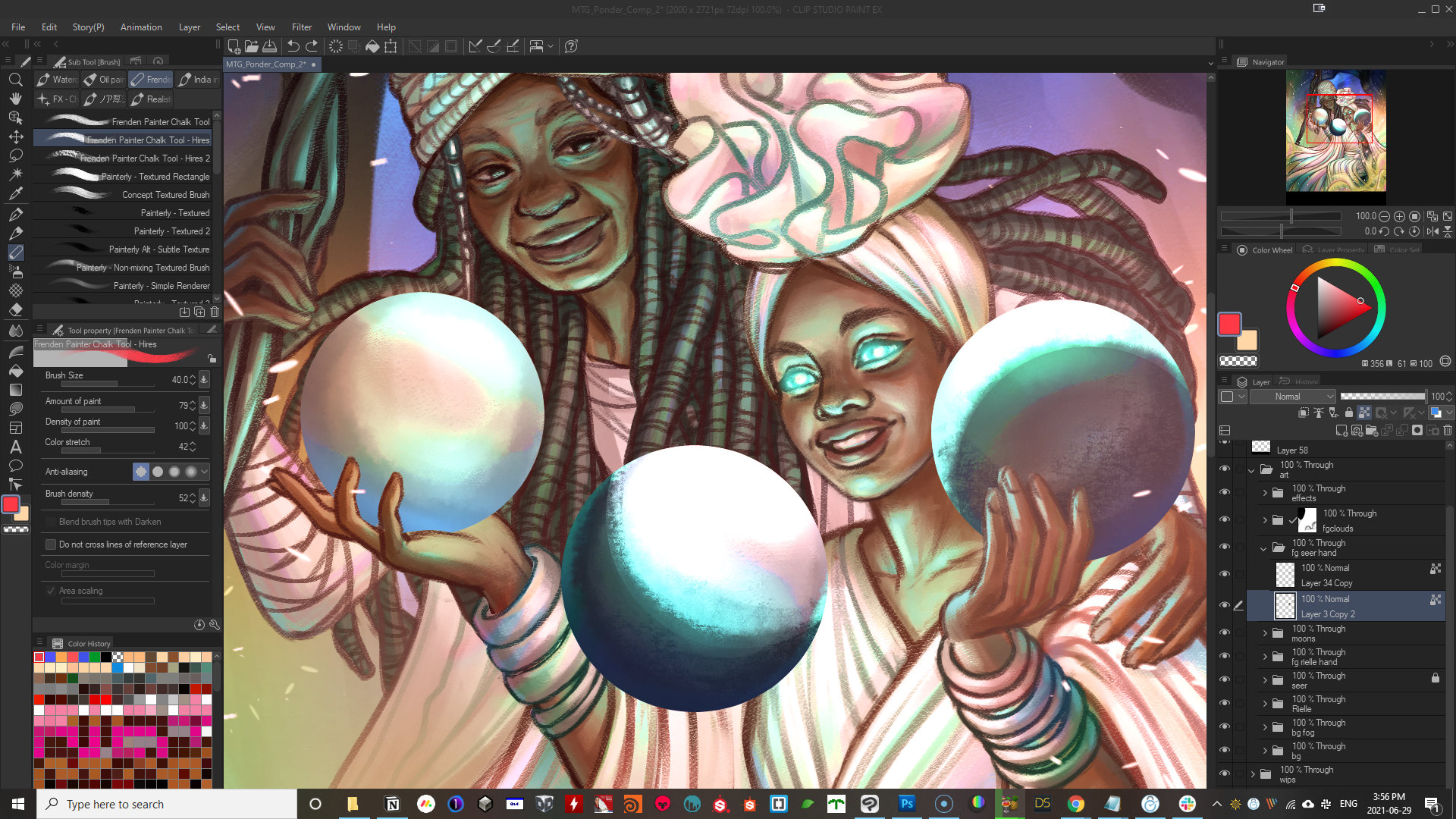
The young seer is described as a pupil of Rielle’s, and I love the flavor text so, so much because I think it does a far better job of answering this question than I ever could. I read it for the first time when the card was announced – it brought out such strong emotions for me, it still does:

“Will the future be brighter?” asked the girl. Rielle smiled. “I will teach you how to make it so.”
What does it mean to you, having been a part of the Black is Magic Secret Lair alongside the other Black female artists?
It’s such an honour! I’m really happy to not only have been included in this set alongside such wonderful fellow Black artists, but also that the set celebrates such vibrant and personal expressions of our existence.
Before we move on, let’s watch Ponder come to life!
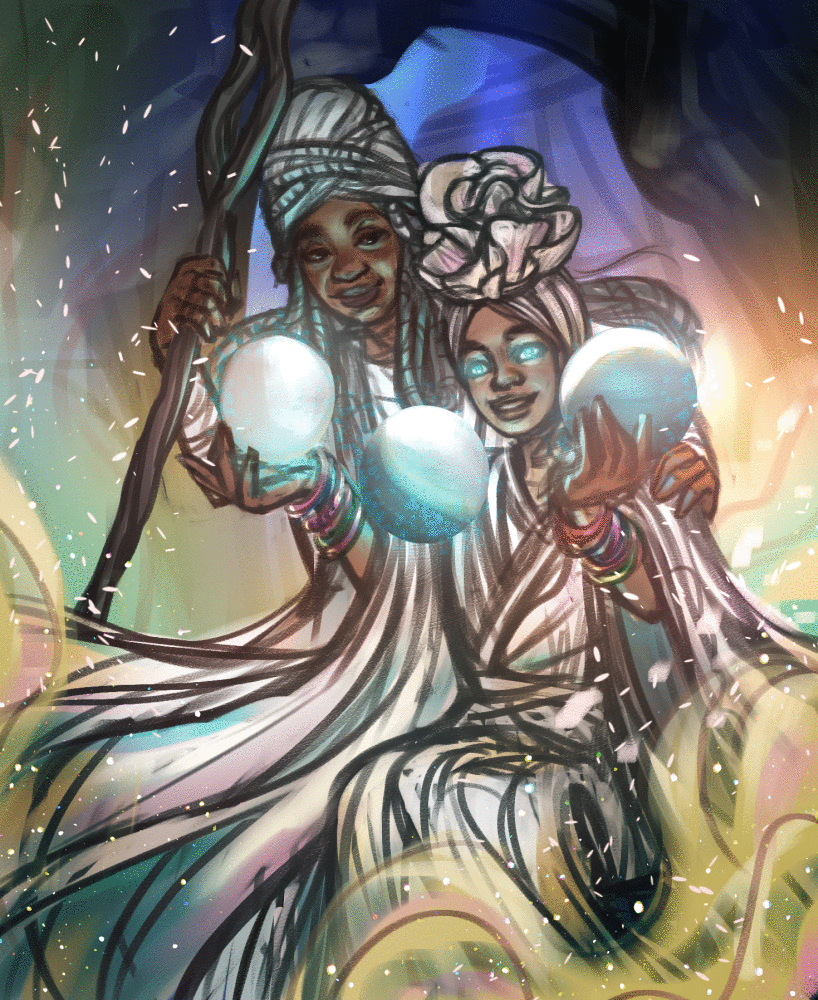
Mother of Runes
You’ve just had your secord card released as well, and it’s Mother of Runes for the Mother’s Day 2021 Secret Lair Drop. Where did you begin once you were given this assignment?
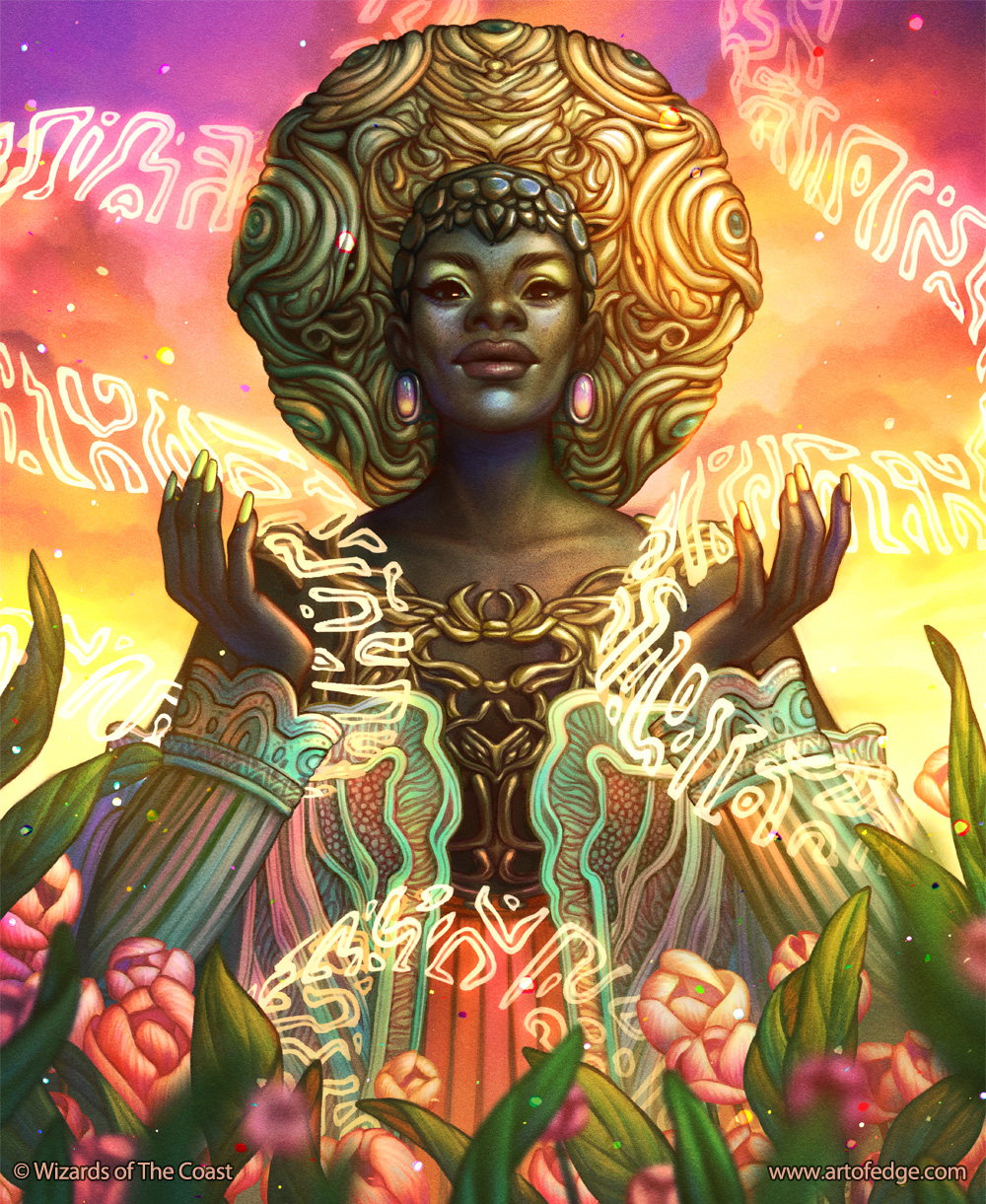
Mother of Rune by Edge. Digital.
The process was pretty similar to Ponder – this time my art director was Tom Jenkot, and he sent along the brief outlining the details for this card. This time however the character design and setting details were left almost fully up to my own interpretation, which was a fun opportunity for some varied design exploration.
As usual, I’ll start with rough sketches – generally once I’ve read the brief, and let it sit for a bit, ideas & connections will start sparking and I’ll start jotting them down. I like to sketch in colour so I usually start with rough colour thumbnail sketches.
I love painting characters with strong, uncompromising gazes, and I decided to sketch one of the options with this in mind – I’m happy that’s the sketch that was chosen (it also included symmetry, one of my favourite elements to explore, so I was doubly thrilled.)
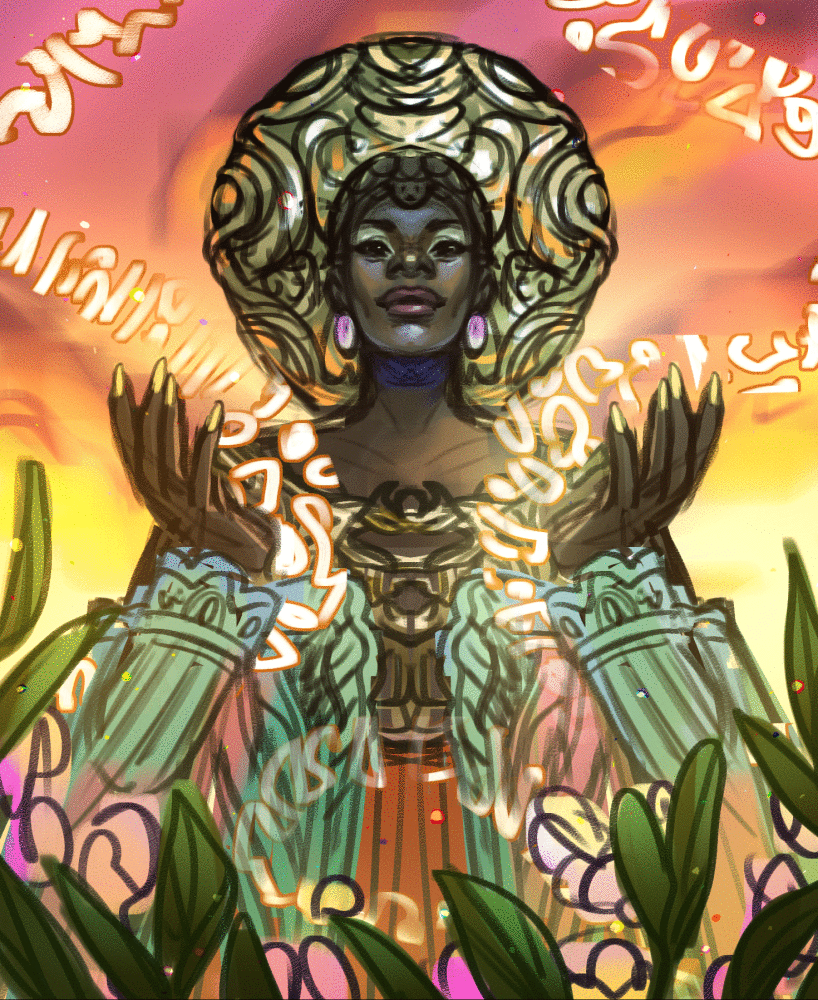
We saw it in the Ponder progression and here as well—bright, bold colors as a part of your underpainting after the sketch. Can you tell me more about these choices and what it helps achieve?
Ah! That’s my ‘flatting’ stage; when I work digitally my process generally goes:
Rough Colour Sketch -> Cleaner Drawing -> Lineart -> ‘Flatting’ (colour layer block-in) -> Final Colours -> Shading -> Final Overpaint & Adjustments.
(For the final painting stage I’ll merge the lineart and colour/shading layers into one, and paint on that flat layer to refine things, soften my lines and add details.)
So my ‘flatting’ stage is when I’m blocking in all the shapes in layers under the lineart, for my eventual final colours & shading. The colours at this stage are purely random, but they do also help me keep track of which layers/elements I’ve already blocked in.
I’m not creating/using them as systemically as a comics flatter would, where each colour corresponds to a specific material/character/element/etc. in the scene, to be used for reliable, repeated selection of those elements throughout the colouring process (hence my quotes).
Instead I’m just working quickly to set up all my layers as necessary, and once that’s done I replace the random colours with the actual colour palette for the piece 😀
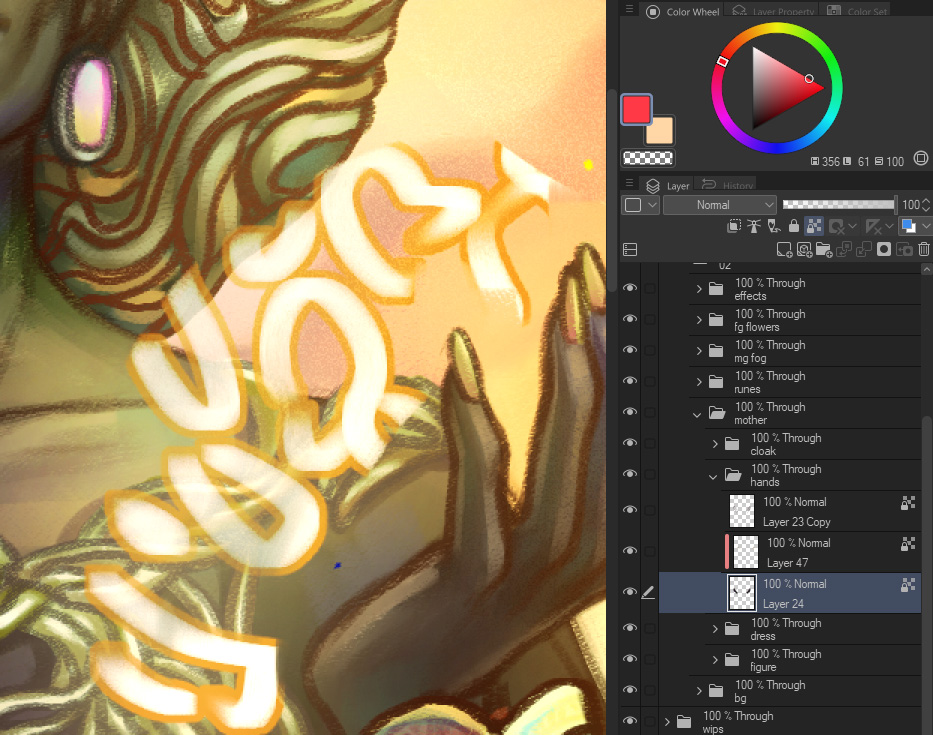
That’s fascinating stuff! Of all the interviews I’ve done it’s never come up before, but what a great step in the process.
Is the Mother we see someone in particular?
She’s not meant to be a direct likeness of anyone, but more an embodiment of what I resonated with when thinking of a powerful mage Mother.
However I was constantly thinking of my own mother while painting this card, and modeling the Mother’s energy and demeanor on hers – and so in that way, this is a portrait of her 🙂
Her clothing and the runes we see in the background—where did you draw inspiration from?
The runes were sort of stream-of-consciousness; I had to make sure I wasn’t copying any real world runes, and so I drew them from scratch, avoiding reference as much as possible, and instead letting the instinct & the overall artwork guide the design.
For the clothing however, I’m pretty sure my love of fantasy RPGs took the reins here haha; I’m really drawn to ornate, imposing designs of mages/magic casters. It also seemed like a great scenario for a striking headdress, and as I was thinking of my mother while creating this piece, I really wanted to echo the gorgeous Nigerian Geles (head wraps) that I remember her wearing when I was younger.
Lastly I hoard a ton of varying fashion references that I often browse through to spark ideas, and so this overall combination of influences resulted in the final design.
A perfect blend of imagination and realism. If you could sum up the meaning of this work in a sentence, what would it be?
A love letter to all guardians who, honouring the incredible power they hold, choose to demonstrate gentleness, kindness, compassion and generosity to their utmost ability, uplifting those around them.
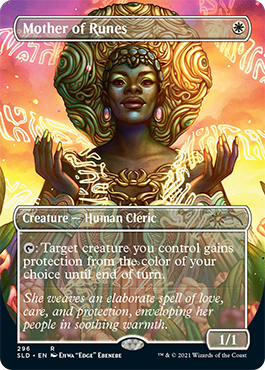
Wrapping Up
I asked Ernanda Souza this same question when I interviewed her earlier this year: “What’s one thing you’d like to say to that young woman or aspiring artist of color who might be reading now, or read this in the future?”
This is a reminder that’s had a lasting impact for me in my creative journey so far, and I’d like to pass it on:
That you, yes you! The world needs your voice, your vision, your stories.
It’s exhausting moving through a world in which obstacles are thrown at us from so many directions, and to start to wonder if we really belong, if we need to compromise our expression to become palatable to others. But they’re just that, lies.
I really believe we hold so much power in our authentic voices.
—-
(I can totally sneak a more art-specific tip in here too, right??)
Of Course!!
For technical artistic improvement, I find that intentional practice beats long-but-unfocused drawing sessions by a loooong shot. Intentional practice for me is about identifying a specific area I’m struggling to draw/paint (eg. hands), and then strategically analysing my attempts to break down what went wrong.
I do this by taking my time to really try and identify specific things bothering me in my piece (eg. the fingertips look weird, but why), then 1.) studying the work of artists I admire to see what they’re doing differently, and 2.) more importantly, observing references of the real thing. (I find it incredibly informative to study these two things together, and understand how different people are interpreting the real-life things, and then to figure out *why* because often that why exposes something I didn’t notice before)
I then work to test out my new findings in my next attempt (eg: I’m realising I keep making the fingertips too pointy, in a way that feels ‘wrong’ rather than intentional, and it’s because I never noticed fingertips are more ‘boxy’ than I realised, so I’ll try drawing a more boxy shape this time), and so on.
I find that practicing mindful, intentional observation, of both our own work, of others we look up to, and our real world can lead to very effective improvement.
I have to ask—will we be seeing more of your work in Magic in the future?
That’s as much of a mystery to me at this point, haha; I’d love to continue illustrating for Magic in the future – I’m totally down for it if they are!
Let’s hope that next card is right around the corner then! And where can folks find you online if they want to follow your work?
- ArtOfEdge.com | ArtStation for my main portfolio(s).
- I’m also on Twitter & Instagram
- And lastly there’s my Patreon, for any folks interested in peeking behind the scenes and/or hearing me ramble about art stuff!
Edge, thanks so much for this incredibly detailed and thoughtful interview. It’s been an absolute pleasure getting to explore your work and learn about all the things that make you, you.
Looking Ahead
I sincerely hope you enjoyed this very special Behind the Brush interview with Edge, and have gleaned something from her immense insight into her artistic process and what makes her artwork so unique. I can’t thank her enough for the time she put into this interview. We need the storytelling voices of folks like Edge in Magic: the Gathering; we must keep looking for the storytellers of tales we’ve not heard and experiences untold, and listening to what they have to say. It’s not only crucial to the art, but Magic is a better game because of the diversity it sows within its artistic ranks.
Next time, we’re headed on an adventure with the Adventures in the Forgotten Realms Grand Art Tour! I’ll do my best to understand the wide world of Dungeons & Dragons, and showcase some brand new cool artwork along the way.
Remember, to see original #mtgart and other #vorthos related things, follow me on Twitter. Feel free to ask questions or retweet to continue the conversation. Thanks and see you next time!
Donny Caltrider has been playing Magic since 2002 and collecting original Magic art since 2017. He has an M.A. in Museum Studies from Johns Hopkins University and enjoys telling stories about art, objects, and the intersection of fantasy with real-life. You can find him on Twitter talking about #mtgart, museums, and other #vorthos related goodness. Follow along and continue the conversation!

